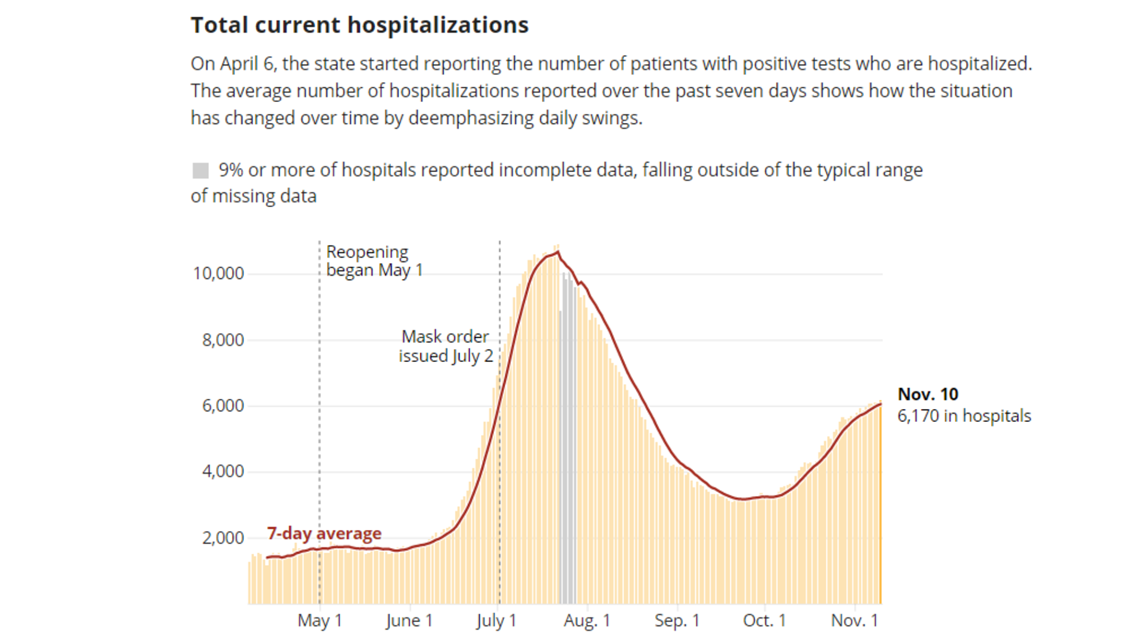This story originally appeared in The Texas Tribune.
The number of coronavirus patients in Texas hospitals has nearly doubled since October, and average infections are at their highest point in almost three months — leaving health officials bracing for a potential crush of hospitalizations going into the holidays.
In El Paso, hospitals are so overwhelmed with COVID-19 patients that in early November the Department of Defense sent medical teams to help, and the county has summoned 10 mobile morgues to hold dead bodies. Local funeral homes are readying extra refrigerated storage space, as the number of hospitalized coronavirus patients in the far West Texas city has shot up nearly tenfold since the start of September.
The new wave of infections stands in contrast to the summer surge, when Gov. Greg Abbott held regular press conferences about the virus and mandated that face coverings be worn, earning him the ire of the far-right. Now, state officials seem reluctant to crack down on the virus’ spread by further curtailing economic activity — and are fighting the El Paso county judge’s attempt to impose a curfew and a stay-at-home order in the face of record-breaking cases.
Health experts say they’re up against a public yearning to return to regular life and tired of following precautions like social distancing and wearing a mask. Unlike the summer, when fear of the virus might have prompted people to heed health officials’ warnings, there’s now a complacency to strictly following safety precautions, experts and officials say.
“In July, everybody's wearing masks. It was 100%. If somebody wasn't wearing a mask, you could just feel the stares at them — and you'd see people like picking up their shirts and covering their noses with it,” said Galveston County health authority Dr. Philip Keiser in a late October interview. Now it's falling into categories: some wear masks, some pull them under their nose or chin — and occasionally there’s open defiance, he said.


The fatigue comes as hospitals in El Paso and parts of West Texas have filled with coronavirus patients, and as other regions have seen steady increases in infections that could presage their own wave of hospitalizations. Cases in Central Texas have hit their highest point since August, with more than half of them involving adults in their 20s and 30s — and officials have said an increase “will lead to needless hospitalizations and deaths.”
Other parts of the state, from the border city of Laredo to Tarrant County, are also seeing an increase in cases.
In Galveston, Keiser said older age groups are becoming infected — different from this summer, when cases there were largely driven by 20- and 30-something-year olds while older people were hospitalized.
Young people are also needing advanced medical care now, like an 8-year-old who “ended up in the hospital and on oxygen,” Keiser said.
“People tend to think of this as a linear type event. And that's not the way it works.” Cases start to increase exponentially, Keiser said, “where it just sort of doubles and doubles and doubles.”
Texas is closing in on 1 million confirmed coronavirus cases, according to state data, and the pandemic has claimed more than 18,700 lives in the state. The number of hospitalized coronavirus patients statewide is a little more than half of what it was this summer, when hospitals along the U.S.-Mexico border were overwhelmed and officials pleaded for a pop up medical facility.
Abbott originally cited a metric called the positivity rate — the portion of tests that come back positive — to gauge the severity of the virus and the appropriate safety measures. The state since late-October has had a positivity rate greater than 10%, the threshold Abbott said was a “warning flag” back in May, though the metric was temporarily unreliable because of problems with the underlying data.
More recently, Abbott has used the hospitalization rate to identify parts of the state where the virus is spreading or where medical resources could be becoming scarce. Areas where more than 15% of hospitalized patients consistently have COVID-19 must shut down bars and limit patrons in restaurants, under Abbott’s order.
The Lubbock and El Paso regions have hospitalization rates respectively near 22% and 40%.
In El Paso, the University Medical Center has hit a record number of coronavirus patients in the hospital, with more than 220 on Nov. 2 — a tremendous upswing from a little over a month before, when there were 30, said spokesperson Ryan Mielke. Multiple floors have been converted to house coronavirus patients, and they have leased space from a children’s hospital to treat adults who are not infected with COVID-19. Emergency medical tents have sprouted up in the hospital’s parking lot, and the state has sent medical staff to open a temporary hospital in the El Paso Convention Center — normally home to events like Comic-Con.
Physicians there have said they think they will see continued growth in the number of patients based on the infection rate, Mielke said.
“We had a surge plan that was actually drafted last spring, so we anticipated these days… However, we did not expect these numbers until later this season,” Mielke said. “We’re expecting this to be a very long winter,” especially with a possible convergence with the flu.
This situation is similar at Covenant Medical Center in Lubbock, where Chief Medical Officer Dr. Brian Schroeder said they are on an upward trajectory with no evidence so far of “peaking.” The number of patients with COVID-19 has climbed in recent weeks, prompting the hospital to dedicate more and more floors to treating people with the virus.
Some 40% of patients in the hospital had the coronavirus as of Nov. 5, compared to an average 20% in the surrounding region. Hours from another metropolitan hub, Lubbock is often a medical destination for those needing advanced or specialized care and Covenant — one of two hospital systems there — frequently accepts patients from small rural hospitals as far away as New Mexico and Kansas.
The hospital has at times been too full to accept transfer patients, and as soon as space opens up, they get more requests for other patients to come, Schroeder said.
The state has sent medical staff to augment strained or short-handed facilities in Lubbock and nearby Amarillo, where the situation in the hospital is similar.
Dr. Sheryl Williams, a hospitalist at BSA Health System in Amarillo, said they have far more patients than they had during an initial wave and that the demographic of those sickened has changed.
In March, there were cases among people who had traveled internationally or to domestic hot spots. Then there was a spike in infections tied to meatpacking plants. Now, it’s “community spread,” Williams said.
”We’re seeing mom and dad and two kids come into the [emergency department] saying ‘I think we all have it,’” she said.
They have expanded the space they use to treat coronavirus patients from a section of one intensive care unit, to the entire unit and part of others, and are doubling up on COVID-19 patients in some rooms.
“We are just hoping we don’t have to expand any further,” Williams said.
Emergency room physician Dr. Robert Hancock said when he worked at a Texoma-area hospital in late-October the entire emergency department was full with patients waiting for an intensive care unit bed to open up. The facility was almost out of ventilators and starting to turn to reserves.
“It’s starting to get like that everywhere now,” said Hancock, who practices in Dallas-Fort Worth, Oklahoma and Amarillo, and is president of the Texas College of Emergency Physicians.
“It’s bad, I think we’re all in agreement at this point. We all were kind of taken by surprise with the outbreak in the summer but this was the one we were all worried about,” he said. “And we’re seeing that progression that many of us were afraid of.”
Elsewhere, last responders — funeral directors who get the dead to a final resting place — are seeing an increase or are girding for more deaths. In Houston, some were warned last month that infections could spread from West Texas to the metro area and that they should begin preparing for a possible uptick in fatalities.
Funeral homes across West Texas and in eastern New Mexico saw a marked increase in virus deaths — to the point that about half are coronavirus-related now, said Bill Vallie, the regional manager of 17 funeral homes there. A dozen employees have become infected outside work, temporarily closing two locations because the staff were quarantining.
“It's like when the storm’s in the Gulf you don't know if it's going to come toward Galveston or if it's going to go up toward Louisiana,” said Greg Compeon, chair of the Texas Funeral Service Commission. Though the volume of deaths is not yet close to the wave of fatalities this summer, he said, the Houston area is seeing an increase and funeral services are being slowed down because loved ones are quarantining or sick, he said.
“We're all kind of holding our breath as to see what happens,” he said.
Disclosure: Texas College of Emergency Physicians has been a financial supporter of The Texas Tribune, a nonprofit, nonpartisan news organization that is funded in part by donations from members, foundations and corporate sponsors. Financial supporters play no role in the Tribune's journalism. Find a complete list of them here.
The Texas Tribune is a nonpartisan, nonprofit media organization that informs Texans — and engages with them – about public policy, politics, government and statewide issues.

